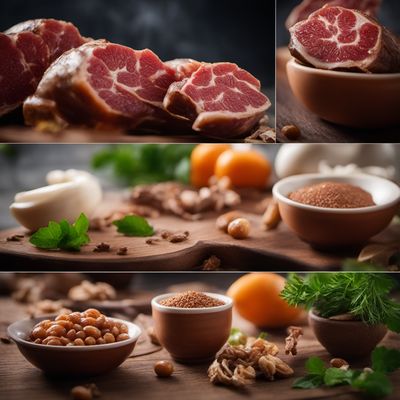
Ingredient
Goat carcase
The Wholesome Base
Goat carcass refers to the meat obtained from goats, which is lean, tender, and has a slightly gamey flavor. It has a firm texture and ranges in color from light pink to deep red, depending on the age of the animal. Goat meat is versatile and can be prepared using various cooking methods, making it a popular choice in many cuisines.
Origins and history
Goat meat has been consumed for centuries and is a staple in many traditional diets, particularly in Africa, Asia, and the Middle East. Goats are hardy animals that can adapt to different climates and terrains, making them a valuable source of food in regions where other livestock may be less viable. The meat is highly regarded for its nutritional value and is often used in celebratory or festive dishes.
Nutritional information
Goat meat is a nutrient-dense protein source that is low in fat and cholesterol. It is rich in essential amino acids, vitamins (such as B vitamins), and minerals (such as iron and zinc). It is also a good source of conjugated linoleic acid (CLA), which has been associated with various health benefits.
Allergens
Goat meat may cause allergic reactions in individuals with a sensitivity to red meat or specific proteins found in goat meat. It is important to consult with a healthcare professional if you suspect an allergy or intolerance.
How to select
When selecting goat carcass, look for meat that is fresh, firm, and free from any unpleasant odors. The color should be vibrant, ranging from light pink to deep red, depending on the age of the animal. If possible, choose meat from younger goats as it tends to be more tender and milder in flavor.
Storage recommendations
To maintain its freshness, goat carcass should be stored in the refrigerator at temperatures below 40°F (4°C). It is best to wrap the meat tightly in plastic wrap or place it in an airtight container to prevent air exposure and minimize the risk of cross-contamination. Use within a few days or freeze for longer storage.
How to produce
Goat carcass can be produced by raising goats on a farm or purchased from local farmers or specialty meat suppliers. Raising goats requires adequate space, proper nutrition, and veterinary care. It is important to follow ethical and sustainable farming practices to ensure the well-being of the animals.
Preparation tips
Goat carcass can be prepared using various cooking methods, including grilling, roasting, stewing, or braising. It is commonly used in dishes such as curries, stews, kebabs, and barbecues. Marinating the meat can help tenderize it and enhance its flavor. Goat meat pairs well with aromatic spices, herbs, and citrus flavors.
Substitutions
Lamb or mutton can be used as substitutes for goat carcass, although they may have slightly different flavor profiles. Beef or pork can also be used as alternatives, but they will significantly alter the taste and texture of the dish.
Culinary uses
Goat carcass is widely used in many cuisines around the world. It is a key ingredient in dishes such as biryani, curry goat, cabrito, and goat stew. It is also used in traditional celebrations or festive meals in various cultures.
Availability
Goat carcass is commonly available in regions where goat farming is prevalent, such as Africa, Asia, the Middle East, and parts of Europe and the Americas. It may be less common or considered a specialty ingredient in other regions.
More ingredients from this category » Browse all

Sheep carcase
The Art of Lamb: Exploring the Versatility of Sheep Carcass

Goose carcase
The Flavorful Foundation

Deer carcase
Venison: The Wild Delicacy

Duck carcase
The Essence of Duck: Unveiling the Secrets of Duck Carcase

Pig carcase
Pig Carcase: A Versatile Ingredient

Wild boar carcase
Untamed Bounty: Wild Boar

Asses-mules-hinnies carcase
The Forgotten Meat

Chicken carcase
The Foundation of Flavor: Unleashing the Potential of Chicken Carcase

Ratites carcase
The Exotic Delicacy: Ratites Carcase Unveiled

Bovine carcase
The Foundation of Flavor

Rabbit carcase
The Art of Rabbit: Unlocking the Culinary Potential of Rabbit Carcass

Turkey carcase
The Versatile Turkey Carcase